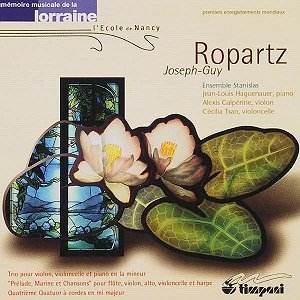|
|
Search MusicWeb Here |
|
 |
||
|
Founder:
Len Mullenger (1942-2025) Editor
in Chief:John Quinn
|
|
|
Search MusicWeb Here |
|
 |
||
|
Founder:
Len Mullenger (1942-2025) Editor
in Chief:John Quinn
|
 |
Joseph-Guy ROPARTZ (1864-1955)
Piano Trio * Prélude, Marine et Chansons + Quartet No. 4 # Alexis Galpérine, violin * Cecilia Tsan, cello * Ensemble Stanislas + Quartet Stanislas # Recorded Salle Poirel, Nancy 1995 and 1996 |
| CD available for post-free online mail-order or you may download individual tracks. For some labels you can download the entire CD with a single click and make HUGE savings. The price you see is the price you pay! The full booklet notes are available on-line. | |
|
NOTE • Click on the button and you can buy the disc or read the booklet details • You can also access each track which you may then sample or down load. • Further Information. |
|
|
Timpani’s superbly produced disc – trilingual notes and slipcase – is part of a series dedicated to the music of the Lorraine. Breton-born Ropartz studied with Massenet and later with Franck, having ditched his legal studies at the Paris bar. He was a youthful director of the Conservatoire of Nancy conducting its symphony concerts and resisting an attempt by D’Indy to poach him for Lyons. On retirement he returned, a Breton to the last, to Brittany. He lived to 91.
Better known generally for his symphonic output he was one of a generation of French composers – Koechlin, Fauré – for whom chamber music was a necessary compositional constituent. The three works recorded here cover a period of nearly thirty years, from the overt Franckisms of the 1918 Trio through the more elusive Prélude, Marine et Chansons to the more robust contrapuntal pleasantries of the Fourth Quartet.
The trio was written during 1918. It is cyclical, honestly Franckian in inspiration with a distinctly withdrawn and lyrical pensiveness – and an affecting amplitude – which manages delineation of voice parts with admirable clarity, given its stylistic models. The second movement has some teasing little open-air lines, a quasi march theme introduced by the piano and taken up by the strings, before a more meditative and harmonically reflective passage is ushered in. The third movement is an interior but never glutinously so. It has a characteristic Ropartz reserve about it. The finale has a freshness and vigour that is very reminiscent of John Ireland’s contemporaneous Second Violin Sonata with its contrasting central passage and romantic largesse.
I admired the 1928 Prélude, Marine et Chansons especially. The work is well chosen to contrast with the occasionally massive sonorities of the trio. By contrast the 1928 work has a simplified, unchromatic, transparent style. Listen to the pellucid textures and birdcall imitations of the final movement for example as an illustration of Ropartz’s increasing refinement of means of expression. The notes by Yves Ferraton call this work a miraculous compromise between concision, sobriety and richness and cites the Baxian Celtic affiliations. I would only add that it has a rare beauty deserving of a dozen recordings.
The Quartet of 1933/34 is the fourth of six composed between 1893 and 1951. This is a return in some ways to the firmness and contrapuntalism of earlier in the century – replete with some staunch chromaticism, vigorous string textures, introspective but never mawkish in the Quasi Lento slow movement. It is a formidably coherent and fluent work with a combustible and compact finale of dancing animation. As I said this is a superbly presented disc which well encompasses the stylistic affinities of a major figure in the history of French chamber music. Strongly recommended.
Jonathan Woolf
See also review by Rob Barnett |
|
ADDITIONAL INFORMATION •
You can sample only 30 seconds (or 15% if that is longer) of a given track. Select from the View tracks list. Each sample will normally start from the beginning but you can drag the slider to any position before pressing play. • PLEASE NOTE: If you are behind a firewall and the sound is prematurely terminated you may need to register Ludwig as a trusted source with your firewall software.
•You will need Quicktime to hear sound samples. Get a free Quicktime download here • If you cannot see the "Sample All Tracks" button you need to download Flash from here.
|
|
|
Return to Index |